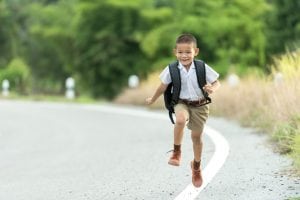Ask kids about their feet at back to school time
- Edgard Diaz
- April 23, 2018
- News

“As soon as your kids start wearing shoes parents need to keep an eye on their development to catch any issues early on,” said Najjarine.
“Kids are often not the best communicators so parents need to ask them about foot pain or any walking or posture issues,” he said.
“Even if the pain is in the neck, it could be due to the feet or other issues with the body’s structure – its biomechanics. Simply believing a child will tell you something is not enough. If you don’t ask you won’t find an answer to something that could be underlying.”
It is well known that problems with a child’s feet can become adult problems if not addressed, such as knee, hip and back pain or serious consequences for future posture.
“Kid’s bones and joints will continue to grow up to adulthood and if there are incorrect movement patterns and untreated foot conditions this can cause supple young bones and joints to develop abnormally. So an annual check is worth it,” he said.
Tips for healthy kids feet*
1. Barefoot crawling: At birth the bones in babies’ feet are not developed – the 26 bones present in an adult foot grow throughout childhood. This is why it is important to let babies remain barefoot as much as possible. Crawling allows the babies’ feet to have direct contact with the ground, promoting balance, control and coordination without the senses being interrupted by shoes or socks – but obviously ensure there is nothing on the ground that can injure their feet.
2. Shoes for support: As soon as your child starts to walk it is recommended that you get them professionally fitted shoes. These protect the feet and supports those wobbly first steps.
3. Fitted shoes: Casual and fashion shoes can adversely affect children’s feet. The reason for this is they may lack support, have thin soles or made of synthetic fibres which do not allow young feet to breathe. The shoe should fit both the length and width of the foot, made of breathable canvas or leather uppers.
4. Fitted socks: Sock sizes should change as frequently as shoe sizes. Supple tiny feet with developing bones can be squeezed into just about anything, but can have negative effects on your child’s foot development. Socks should not be too tight or too lose that they bunch up inside the shoe, causing blisters or other injuries that can change how your child walks.
5. Measure growing feet regularly: A child’s feet grow very quickly leading to shoes that are too tight. Therefore regularly measure you child’s feet to ensure the shoes they are wearing fit correctly. Ill-fitting shoes can cause pain and discomfort as well as affect the correct development of the feet.
* Australian Podiatry Association


